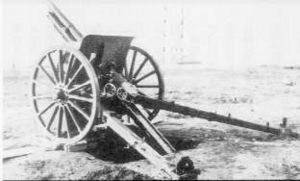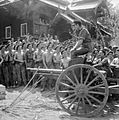Type 95 75 mm field gun facts for kids
Quick facts for kids Type 95 75 mm field gun |
|
|---|---|

Type 95 75 mm field gun
|
|
| Type | Field gun |
| Place of origin | |
| Service history | |
| In service | 1936-1945 |
| Used by | |
| Wars | World War II |
| Production history | |
| Designer | Osaka Arsenal |
| Manufacturer | Osaka Arsenal |
| No. built | 261 |
| Specifications | |
| Mass | 1,106.6 kilograms (2,440 lb) |
| Barrel length | 2.278 metres (7 ft 6 in) L/30.67 |
|
|
|
| Shell | 6.33 kilograms (14.0 lb) |
| Caliber | 75 mm (2.95 in) |
| Breech | Sliding wedge |
| Recoil | Hydropneumatic |
| Carriage | split trail |
| Elevation | -8° to +43° |
| Traverse | 50° |
| Muzzle velocity | 500 m/s (1,640 ft/s) |
| Maximum firing range | 10,970 meters (12,000 yd) |
| Sights | Panoramic |
The Type 95 75 mm Field Gun (also known as Kyūgo-shiki yahō in Japanese) was a powerful field gun used by the Imperial Japanese Army. It played a role during World War II.
This type of artillery was designed to replace older guns like the Type 38 75 mm field gun and the Type 41 75 mm cavalry gun. However, even with the new Type 95, the older Type 38 guns were still used in battles.
A Look Back: How the Gun Was Made
Before a big war called World War I, the Japanese Army mostly used cannons made by a German company called Krupp. After the Treaty of Versailles, which ended World War I, Japan started looking at other options. They became interested in field guns designed by a French company called Schneider et Cie.
In 1931, the Imperial Japanese Army began using a gun called the "Type 90." This gun was based on the French Schneider designs. However, the Type 90 was not considered very successful.
Because of this, the Type 95 was created. It was designed to be simpler and stronger than the Type 90. This made it easier to build and more reliable for soldiers to use in the field.
Where it was Used
The Type 95 field guns were used in battles during the Second Sino-Japanese War. This was a major conflict that happened before and during World War II.
Related pages
Images for kids
-
Lord Louis Mountbatten, a top Allied commander, sitting on a captured Japanese 75 mm gun in Mandalay, March 21, 1945.


